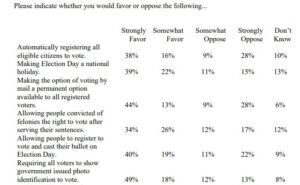The following article by Ruy Teixeira, author of The Optimistic Leftist and other works of political analysis, is cross-posted from his blog:
The growth of dynamic metropolitan America and the faltering of much of the rest of the country is hugely important to understanding the evolving political terrain of the country. Many on the left prefer to reduce the story to one of xenophobic, racist reaction to a demographically changing country but this is lazy, self-congratulatory thinking.
Bill Galston provides a more sympathetic–and more accurate–interpretation of the heartland revolt in an excellent article in Francis Fukuyama’s new site, American Purpose. Here Galston provides a concise summary of why “they” don’t like “us”.
“They” see “us” as presiding over a long-term decline in their quality of life without lifting a finger to help. Blue-collar wages have stagnated for decades; good jobs for which they are qualified have evaporated. Their suffering went ignored by elites in both political parties until Donald Trump emerged as their champion.
They fear falling even farther. (Behavioral economics tells us that losses sting more than gains please.) They do not understand why this is happening to them and are searching for an explanation, which only conservative populists bother to provide.
They have a sense of displacement in a country they once dominated. Immigrants, minorities, non-Christians, even atheists have taken center stage, forcing them to the margins of American life. The metropolitan areas we dominate—and that dominate the country—embody a way of life increasingly at odds with Americans in small towns and rural areas.
They believe we have rewritten the rules to rig the game against them. We have redefined success so that it is measured by test taking, which leaves them on the outside looking in. We have established a hereditary meritocracy based on our networks, resources, and inside knowledge of the rules. We tell them they should shape up and get with the New Economy, but never say how they are supposed to do that. They believe we have used our power for our own advantage, not to promote a common good that would include them.
They believe our claims to expertise are mostly bogus. Why did elites in both parties allow China to join the World Trade Organization on such favorable terms? Why did they plunge us into endless wars in the Middle East? Why did they cause the Great Recession and botch the recovery? Why have their medical experts changed their minds so often during the pandemic? President Trump was at his best, they say, when he ignored the experts and went his own way.
They believe that we deny their freedom and tell them how to live their lives. Why do we regulate the way they farm, fish, and hunt? Why do we prefer endangered species over their human families, shut down their businesses, and try to close their churches?
They believe we have a powerful desire for moral coercion. We tell them how to behave—and, worse, how to think. When they complain, we accuse them of racism and xenophobia. How, they ask, did standing up for the traditional family become racism? When did transgender bathrooms become a civil right?
They see us using the law to make them act in violation of their deepest beliefs—making the Little Sisters of the Poor cover contraception, forcing public schools to allow entrance to bathrooms based on gender identity. They believe we want to keep them from living in accordance with their faith.
They believe we hold them in contempt. They point to remarks by 2008 and 2016 Democratic presidential nominees as evidence.
Finally, they think we are hypocrites. We claim to support free speech—until someone says something we don’t like. We claim to oppose violence—unless it serves a cause we approve of. We claim to defend the Constitution—except for the Second Amendment. We support tolerance, inclusion, and social justice—except for people like them.”
Galston pointedly remarks that this viewpoint is not entirely wrong, despite how many of “us” reflexively reject it.
“Although our natural inclination is to resent and reject these allegations, we should ask whether there is some merit to them. Donald Trump did not create these sentiments. They will not disappear just because his presidency has ended.”
It is my view that this lesson has not yet been absorbed by metro America’s cosmopolitan left. It is likely “we”–and the country–will pay a heavy price for this failure.





